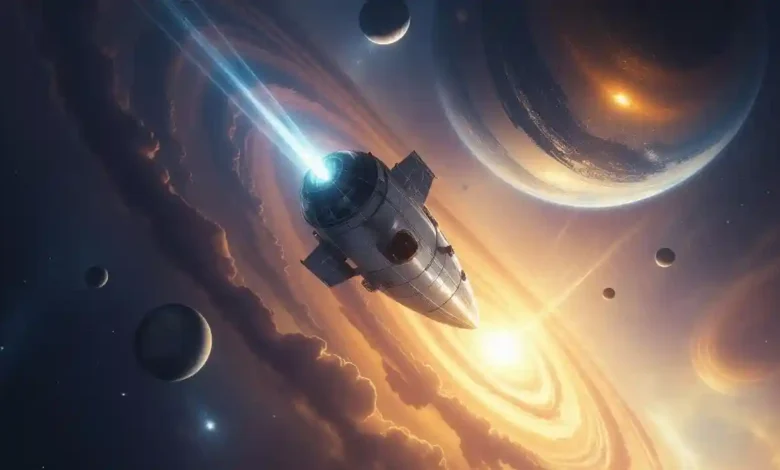The Quantum Leap Technologies Humanity Needs for Interstellar Travel

The latest “Avatar: Fire and Ash” trailers have once again ignited our collective imagination, pulling us back into the breathtaking, bioluminescent embrace of Pandora. As we marvel at its exotic flora and fauna, a primal human question whispers: What if? What if, somewhere in the vast cosmic ocean, a world as stunningly vibrant as Pandora awaits our discovery? And more profoundly, if such a paradise exists, perhaps even in a stellar neighborhood as close as Alpha Centauri, what astonishing technologies would humanity need to bridge such an unfathomable distance?
The journey to Alpha Centauri, our nearest star system at a “mere” 4.37 light-years, is not just a hop, skip, and a jump. It’s a monumental undertaking that dwarfs every engineering feat in human history. It’s a journey that demands a complete re-evaluation of our understanding of physics, propulsion, and even human longevity.
Let’s dive into the revolutionary technologies that would transform humanity from a planetary species into an interstellar civilization:
1. The Alcubierre Drive: Bending Spacetime Itself
Forget rockets as we know them. Even traveling at the speed of light, Alpha Centauri is over four years away. For practical interstellar travel within a human lifetime, we need to cheat the cosmic speed limit. Enter the Alcubierre Drive, a theoretical solution to faster-than-light (FTL) travel, often dubbed the “warp drive.”
The concept is elegant: instead of moving through space, a warp drive would compress space in front of the spacecraft and expand space behind it. The ship itself would remain stationary within a “warp bubble,” effectively surfing a wave of distorted spacetime. This wouldn’t violate Einstein’s theory of relativity because the ship isn’t exceeding the speed of light locally.
Technological Hurdles: The primary challenge lies in the immense, negative energy density required to create and sustain such a warp bubble. Exotic matter with negative mass or negative energy density, while theoretically possible, has yet to be observed or created in any meaningful quantity. Harnessing and manipulating such extreme forces would require a fundamental breakthrough in quantum physics and energy generation on an unprecedented scale. Think Dyson Spheres for power, and particle accelerators that make the Large Hadron Collider look like a child’s toy.
2. Antimatter Propulsion: The Ultimate Rocket Fuel
If warp drives prove elusive, antimatter propulsion offers the most energy-dense reaction known to physics, far surpassing nuclear fusion. When matter and antimatter collide, they annihilate, converting 100% of their mass into energy, primarily gamma rays. This makes it an incredibly efficient propellant.
A small amount of antimatter could provide the thrust to accelerate a spacecraft to a significant fraction of the speed of light – say, 10-20% C (the speed of light). At 10% C, Alpha Centauri would still be a 40-year journey, but within the realm of a single human generation.
Technological Hurdles: The challenges are colossal:
- Antimatter Production: Creating antimatter is currently incredibly inefficient and energy-intensive. It takes far more energy to produce antimatter than the energy gained from its annihilation. We’d need industrial-scale antimatter factories operating with unimaginable efficiency.
- Antimatter Storage: Antimatter cannot touch normal matter. It must be contained in powerful magnetic fields within a vacuum, often called a “Penning trap.” Storing enough antimatter for an interstellar journey without it touching the container walls for decades is an immense engineering challenge.
- Gamma Ray Shielding: The annihilation process produces highly energetic gamma rays, which are dangerous to the crew and could damage the spacecraft. Robust, advanced shielding materials would be crucial.
3. Fusion Power: The Steadfast Interstellar Engine
While antimatter offers explosive power for rapid acceleration, controlled nuclear fusion provides a sustained, incredibly powerful, and relatively “cleaner” energy source for long-duration journeys. Technologies like inertial confinement fusion or magnetic confinement fusion (tokamaks) aim to harness the same process that powers stars.
For an interstellar vessel, a fusion reactor would not only power the propulsion system but also provide all the energy needed for life support, scientific instruments, and internal systems for decades or even centuries.
Technological Hurdles: Despite decades of research, sustained, net-positive fusion power remains elusive. We need breakthroughs in plasma confinement, materials science (to withstand extreme temperatures and radiation), and energy extraction efficiency. The scale of a fusion reactor capable of propelling a starship would be immense, requiring innovative miniaturization techniques without compromising power output.
4. Advanced AI and Automation: The Unblinking Crew
The sheer duration of interstellar voyages means that human crews will face unprecedented psychological and physiological challenges. This is where advanced AI and automation become not just helpful, but essential.
- Autonomous Navigation: An AI navigator could constantly calculate optimal trajectories, identify hazards, and make real-time adjustments far beyond human capability.
- Ship Maintenance and Repair: Fleets of robotic drones and AI systems would tirelessly monitor, maintain, and repair every component of the starship, from hull integrity to life support, for decades on end.
- Scientific Discovery: Upon arrival, AI could be deployed for initial planetary surveys, sample collection, and data analysis, providing critical information before human boots hit the ground.
- Crew Support: AI companions could provide psychological support, monitor vital signs, and manage routine tasks, freeing human crew for more complex problem-solving and decision-making.
Technological Hurdles: Developing truly agentic, self-improving AI capable of operating independently for centuries in extreme environments is a monumental task. This includes robust decision-making algorithms, advanced machine learning, and ethical frameworks to ensure AI aligns with human goals.
5. Life Support Systems: A Self-Sustaining Ark
An interstellar vessel is essentially a closed ecosystem, an ark carrying humanity across the cosmic void. The life support systems must be incredibly robust, self-regenerating, and highly efficient.
- Closed-Loop Recycling: Water, air, and waste must be recycled with near 100% efficiency. This involves advanced atmospheric processors, water purification systems, and bio-regenerative waste management (think algae farms converting waste into oxygen and nutrients).
- Artificial Gravity: Long-duration exposure to zero-gravity is detrimental to human health (bone density loss, muscle atrophy). Rotational sections of the ship could provide artificial gravity, or advanced “gravimetric” technologies (if discovered) could simulate it without rotation.
- Radiation Shielding: Interstellar space is awash in cosmic radiation, a significant threat to human health. Advanced materials and active magnetic shielding would be necessary to protect the crew and sensitive equipment.
Technological Hurdles: Creating truly self-sustaining, resilient ecosystems that can operate flawlessly for decades without external resupply is a staggering challenge. This requires breakthroughs in material science, synthetic biology, and ecological engineering.
6. Hibernation/Stasis Technologies: The Long Sleep
Even with FTL concepts like the Alcubierre drive, or near-lightspeed travel with antimatter, journeys could still be long. To mitigate the psychological strain and resource consumption of a multi-decade voyage, some form of human suspended animation would be invaluable.
- Induced Torpor/Hibernation: Medical science is slowly unraveling the secrets of animal hibernation. If we could induce a similar metabolic slowdown in humans, it would dramatically reduce oxygen, food, and water requirements, and slow down the aging process.
- Cryosleep: The more speculative option involves freezing humans for centuries and reanimating them upon arrival. While currently fraught with issues like cellular damage from ice crystal formation, future advances in nanotechnology and molecular repair might make it viable.
Technological Hurdles: Mastering human hibernation is a complex biological puzzle. Cryosleep, in particular, requires fundamental breakthroughs in cell preservation and repair at the molecular level – essentially, rebuilding the body from frozen components.
7. In Situ Resource Utilization (ISRU): Living Off the Land (or Asteroids)
A truly self-sufficient interstellar civilization wouldn’t rely solely on what it launches from Earth. The ability to extract and process resources from asteroids, comets, or even moons encountered en route or in the target system would be critical.
- Autonomous Mining and Refinement: Robotic mining probes could extract water ice for fuel (electrolysis into hydrogen and oxygen), metals for construction, and rare elements for advanced technologies.
- 3D Printing and Additive Manufacturing: Onboard 3D printers using a variety of materials would allow for on-demand repair, replacement parts, and even the construction of new components from raw materials.
Technological Hurdles: Developing robust, self-replicating robotic systems capable of operating autonomously in hostile environments, coupled with advanced material science for versatile 3D printing, is a prerequisite.
The Pandora Paradox: A Cosmic Imperative
The dream of discovering another Pandora is a powerful motivator. It speaks to our innate curiosity, our desire for beauty, and our yearning for new horizons. But the journey itself forces us to confront our limitations and push the boundaries of what we deem possible.
The technologies required for interstellar travel are not merely incremental improvements; they represent quantum leaps in physics, engineering, and biology. They would fundamentally transform human society, energy production, and our understanding of life itself.
Perhaps the greatest lesson from imagining the journey to a distant Pandora isn’t just about reaching a new world, but about the incredible evolution humanity must undergo to get there. It’s a vision that demands the brightest minds, the most daring spirits, and a unified global effort – a true testament to our insatiable drive to explore, to understand, and to dream beyond the stars.
So, as we watch the “Avatar: Fire and Ash” trailers and lose ourselves in the wonder of a fictional world, let it also be a catalyst for real-world ambition. The technologies described here are not science fiction impossibilities, but rather the ultimate engineering challenges of tomorrow. And who knows, one day, humanity might just build the vessel that takes us to our own real-life Pandora.
For more Odinozz interesting articles, click here.
Follow Odinozz on social media. Click here.



